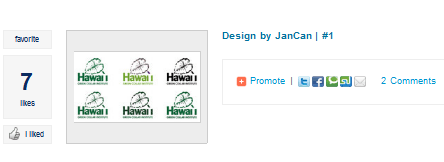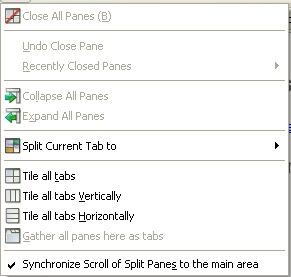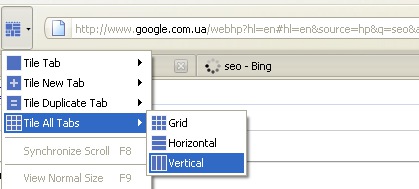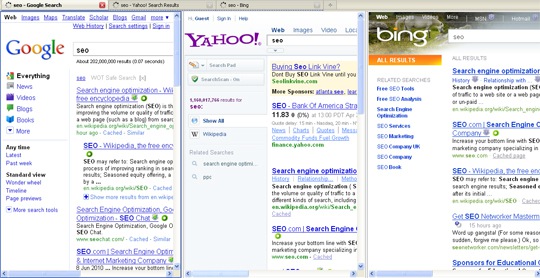cooperativa caleruega maquinaria agrícola caleruega taller mecanico caleruega oficinas bancarias caleruegaUpdates from:
"Search Engine Journal" - 2 new articles
- Prova.fm : Crowdsourcing for Banner Designs
- Split FireFox into Several Frames for Better Productivity and More
- More Recent Articles
- Search Search Engine Journal
Prova.fm : Crowdsourcing for Banner Designs
Banner advertising has a dual purpose: getting your brand out there, and boosting ROI. The main reason many advertising campaigns fail is related to design – poor design that is. DIY strategies for economy work only for those who are already designers, especially if they are experienced enough to make a market audit, to understand what their targeted audiences like to see, and what they react to.
There is a very important aspect that cannot be overlooked – banner advertising, when done right, targets the short term revenue and the long term brand placement. Consumers might not have an immediate need to purchase a product, but they might remember a brand because of an impactful advertisement. Images and symbols are sticky – and a web user may remember the name of a company months after being exposed to a banner.
The best way to get a quality banner is to ask a number of designers to submit ideas, proposals and sketches. Then, ideally, these sketches should be scrutinized by a group of relevant people for feedback on what they like, why they like it, whether they will remember the ad, and so on. For small businesses, this is challenging and costly. A cost effective alternative, although somewhat controversial, is crowdsourcing.
Many accomplished designers, who already made their mark, and are well known, brand crowdsourcing and "design contests" in general as exploitative, and 'spec', or speculative work. Many of them see this practice as a "cesspool of copyright infringement" and "harmful for the design profession." This is for obvious reasons.
But, crowdsourcing is not a new trend – many businesses have been using the practice outside the web for years. In 1922 Robert McCormick organized a design competition to get designs for the tower that currently houses The Chicago Tribune. The competition offered $100,000 in prize money, with a $50,000 1st prize for "the most beautiful and distinctive office building in the world." The competition attracted 263 entries, and it was won by John Mead Howells and Raymond Hood. Their building still stands, a solid proof that design contests are probably the best way to get a good design.The advocates of crowdsourcing usually think that the critics of the practice fear competition. Whether this is the case or not, is anyone's guess. But, the lesson learned from the Tribune contest in 1922 bears witness to a valid strategy. Sure, online design contests attract a number of inexperienced participants, many of which are not even designers. Sure, it is very likely that some of them are cheating by submitting copied work, and this is a serious risk for the entrepreneurs who organize the contests, if they select the infringing work as a contest winner. But, such instances are fortunately very rare, and now, there is at least one website that found a way to ensure that designs get enough community feedback to avoid negative scenarios.
Prova.fm is an ad agency and a crowdsourcing platform that takes a social approach to business, integrating social networking features like Facebook, Twitter and Buzz, to allow designers participating in a contest to promote their contest entries within their networks of friends, get feedback from their peers and so on.
Entrepreneurs who use Prova to get a design can use the same tools to ask for feedback from their own online friends and customers. In addition, each design entry has an associated "I like" button, that allows visitors to vote for the designs they like best. This voting system allows contest organizers to track audience preference. However, the winner of the contest can be selected independent from these "likes" – the organizer alone is the one who decides the winner.
In the end, the designs created through Prova are designs with the proper headlines, unique angle, and call to action that attract the best market for a given business.
There are many value points for designers as well, as Prova wants to be the ideal launching pad for emerging designers. All winners get to be promoted on Prova's sites and partner sites as well, on social networks like Facebook and Twitter, and even in printed newspapers and magazines.
There are other crowdsourcing sites as well, some older in the business than Prova, like 99designs.com and CrowdSpring. But Prova is the only one with such a community aspect, and the tools to make a difference and to bring something positive to the market, by helping emerging designers to get early career exposure, in addition to cash prizes. An insider tip: Prova will organize a number of contests in the following months, to involve its own community to create the company's logo, landing page, banners and many other designs.
Not every company has the where-with-all to hire the most famous design team in the world. And, the most talented designers are not always the most famous ones. Brand advertising is one of the most crucial aspects of any business. But for advertising and marketing to be great, the cost does not always have to be. Crowdsourcing can have a huge impact on any campaign aspect, and with services like Prova, 99designs and CrowdSpring the crowd supplies so many benefits.
Disclaimer: Prova.fm is a Pamil Visions PR customer. The opinions expressed here are the author's alone. SEJ is not affiliated with Prova or Pamil Visions in any way.
Check out the SEO Tools guide at Search Engine Journal.
Prova.fm : Crowdsourcing for Banner Designs

Split FireFox into Several Frames for Better Productivity and More
As an active Internet user, I browse hundreds of pages daily. Sometimes I have dozens of tabs open and I have to switch quickly between them.
To enhance my productivity I am now playing with a couple of screen-splitting tools that are aimed to help me:
- Quickly compare search results (of various (local) search engine versions, of different search engines – e.g. Google versus Bing, – etc.)
- Quickly switch between tabs (especially for reference notes, quoting, note taking, etc);
- Easily read, keep notes, summarize – everything in one window.
Now, let me share the two tools:
1. Fox Splitter
Fox Splitter is an option-rich FireFox addon that offers you the various splitting features:
- Split current tab;
- Tile all tabs;
- Tile all tabs vertically / horizontally;
- Access recently closed panes;
- Collapse / Expand all panes:
It can be accessed in various ways:
- Choose the "Split Browser to" menu in the context menu.
- Choose the "Load in Split Browser" menu in the context menu on link.
- Click popup-button on top/bottom/left/right edges of the content area.
- Drop links, bookmarks, tabs, etc. to popup-button on top/bottom/left/right edges of the content area while dragging.
2. Tile Tabs
Tile Tabs – this one is also really rich in features and settings (and I can't still choose between the two actually). The menu options include:
- Tile Tab – adds an existing tab as a new tile above, left, right or below the currently selected tile.
- Tile New Tab – opens a new tab as a new tile above, left, right or below the currently selected tile.
- Tile Duplicate Tab – opens a duplicate tab as a new tile above, left, right or below the currently selected tile.
- Tile Link in New Tab – opens a link in a new tab as a new tile above, left, right or below of the currently selected tile.
- Untile Tab – removes a tile and the corresponding tab reverts to normal operation.
- Expand Tile – expands a tile and collapses all the other tiles in that group (or use F2).
- Tile All Tabs – adds all tabs as tiles together horizontally, vertically or in a grid.
- Untile All Tabs – removes all tiles and all tabs revert to normal operation.
The toolbar button is really nicely done and requires no extra instructions:
The result looks cool in both the cases – definitely a time-saver!
Check out the SEO Tools guide at Search Engine Journal.
Split FireFox into Several Frames for Better Productivity and More
More Recent Articles

Click here to safely unsubscribe now from "Search Engine Journal" or change your subscription or subscribe
"Gizmos" - 3 new articles
- Maingear muestra el PC de sobremesa F131 P55 3D Vision Surround
- A escena el Onkyo DX1015A5, netbook de doble pantalla
- Fujitsu presenta un nuevo tablet, el LifeBook TH700
- More Recent Articles
- Search Gizmos
Maingear muestra el PC de sobremesa F131 P55 3D Vision Surround
Cuando la compañía CyberPower se puso manos a la obra con sus PCs de sobremesa preparados para tecnología 3D, ya nos imaginamos que una de sus principales competidoras, Maingear, no tardaría demasiado en seguir su camino. Ahora la empresa anuncia su ordenador de sobremesa F131 P55 3D Vision Surround, con el que se introducen también en el sector de la visualización 3D completa.
Se trata de un ordenador dirigido al gaming altamente personalizable y con una capacidad muy elevada para exprimir al máximo todos los juegos.
Cuenta con discos duros SATA, tecnología de overclocking Redline, y multitud de tarjetas de vídeo en Crossfire o SLI. Además, dispone de un sistema laser personalizado M.A.R.C. El ordenador se fundamenta en un procesador Intel Core i3/i5/i7, con dos tarjetas GeForce GTX 470, 4GB de memoria RAM, y un disco duro de 640GB (hasta cuatro HDDs). Incluye también grabadora de DVD, sistema de sonido de alta definición Surround 7.1+2 con soporte S/DIF óptico de entrada y salida, y ethernet Gigabit. Se complementa de tres monitores 3D de 23 pulgadas Acer GD235HZ y un kit 3D Vision.
Su coste en la configuración básica es de 3770 dólares, unos 3000 euros.
En Gizmos: MainGear presenta el notebook eX-L 17 - El Assassin es el nuevo ordenador para gaming de Digital Storm
Related posts:
- A escena el Vype Gaming, un nuevo ordenador de sobremesa para juegos
- MAINGEAR Remix Workstation, potente ordenador para edición multimedia
- Maingear mX-L, con SSD y Blu-ray
- Nuevo sistema de sonido de Kenwood, con DTS Surround Sensation
- MainGear presenta el notebook eX-L 17
Copyright © 2008
This feed is for personal, non-commercial use only.
The use of this feed on other websites breaches copyright. If this content is not in your news reader, it makes the page you are viewing an infringement of the copyright. (Digital Fingerprint:
Entrada Original: )
A escena el Onkyo DX1015A5, netbook de doble pantalla
Quienes suelen sacarle pegas a los netbooks por contar con pantallas demasiado pequeñas, van a encontrar en éste nuevo producto de Onkyo un lanzamiento de lo más interesante. Se trata del netbook DX1015A5, que cuenta como principal atractivo con un sistema de pantalla dual.
Cada una de las pantallas es de 10.1 pulgadas con resolución de 1024 x 600 píxeles.
Éste netbook convertible de Onkyo cuenta con procesador AMD Athlon Neo MV-40 a una velocidad de 1.6GHz, y un chipset AMD M780G. Su memoria RAM comienza en 1GB, pero puede aumentarse hasta los 4GB, mientras que el disco duro tiene una capacidad de 160GB.
Además, incluye cámara de 1.3 megapíxeles, conexión Wi-Fi y Ethernet, sistema operativo precargado Windows 7 Home Premium, y una batería que garantiza el uso continuado del ordenador durante casi 4 horas. Su lanzamiento está previsto para éste mes al precio de 815 dólares, unos 655 euros.
En Gizmos: MSI presenta el nuevo netbook Wind U135DX - Samsung presenta el netbook N230
Related posts:
- Onkyo X-NX10A, estéreo con 80GB
- Onkyo AERO Sound System
- Onkyo KM-2W, teclado y ratón inalámbrico
- Onkyo MHP-UW2, auriculares inalámbricos para iPod
- Onkyo DV-HD805
Copyright © 2008
This feed is for personal, non-commercial use only.
The use of this feed on other websites breaches copyright. If this content is not in your news reader, it makes the page you are viewing an infringement of the copyright. (Digital Fingerprint:
Entrada Original: )

Fujitsu presenta un nuevo tablet, el LifeBook TH700
La familia LifeBook está a punto de crecer (de nuevo), y es que Fujitsu últimamente no se detiene ante nadie. Tras la presentación sólo hace unos días del LifeBook PH520/1A, la marca vuelve al mercado con el tablet convertible LifeBook TH700, que estará a la venta en Estados Unidos desde el día 5 de julio.
Su precio será de 1100 dólares norteamericanos, unos 880 euros al cambio.
Dentro del LifeBook TH700 nos encontramos un procesador Intel Core i3-350M que funciona a una velocidad de 2.26GHz. Su tarjeta gráfica es una Intel HD integrada, y el dispositivo cuenta con 4GB de memoria RAM. Para almacenar todo lo que necesitemos dispone de un disco duro de 320GB.
También incorpora salida HDMI, una pantalla de modo dual de 12.1 pulgadas con resolución 1366 x 768 píxeles, conexión Wi-Fi, Ethernet, y Bluetooth 2.0. Además, el LifeBook TH700 tiene lector de huellas digitales por motivos de seguridad y sistema operativo Windows 7 Premium precargado.
En Gizmos: Fujitsu presenta el LifeBook PH520/1A - Fujitsu presenta el mini-notebook Lifebook MH330
Related posts:
- Fujitsu LifeBook T2010
- Fujitsu presenta el LifeBook PH520/1A
- Fujitsu LifeBook S6510, ligero y caro
- Fujitsu presenta el mini-notebook Lifebook MH330
- Fujitsu LifeBook A3130
Copyright © 2008
This feed is for personal, non-commercial use only.
The use of this feed on other websites breaches copyright. If this content is not in your news reader, it makes the page you are viewing an infringement of the copyright. (Digital Fingerprint:
Entrada Original: )
More Recent Articles

Click here to safely unsubscribe now from "Gizmos" or change your subscription or subscribe
Unsubscribe from all current and future newsletters powered by FeedBlitz
Your requested content delivery powered by FeedBlitz, LLC, 9 Thoreau Way, Sudbury, MA 01776, USA. +1.978.776.9498
sábado, 3 de julio de 2010
5 new articles
Suscribirse a:
Enviar comentarios (Atom)
Seguidores
Archivo del blog
-
▼
2010
(127)
- ► septiembre (7)
-
▼
julio
(23)
- 6 new articles
- 9 new articles
- 6 new articles
- 9 new articles
- 4 new articles
- 5 new articles
- 12 new articles
- 4 new articles
- 3 new articles
- 5 new articles
- 6 new articles
- 8 new articles
- 9 new articles
- 8 new articles
- 3 new articles
- 3 new articles
- 7 new articles
- 7 new articles
- 4 new articles
- 5 new articles
- 7 new articles
- 8 new articles
- 8 new articles










No hay comentarios:
Publicar un comentario